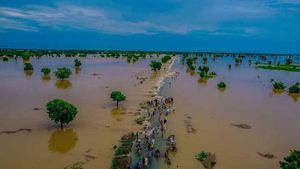Japan has once again reminded the world of its precarious position on the Pacific Ring of Fire, as the recent 7.1-magnitude earthquake rattled the southwestern part of the country, triggering distress and reminders of the seismic threats lurking beneath the ocean floor. The quake struck off the coast of Miyazaki Prefecture on the afternoon of August 8, 2024, prompting immediate tsunami warnings for several western islands. Fortunately, most injuries reported were minor, with only nine individuals on Kyushu island requiring medical attention.
The earthquake, initially measured at 6.9 by seismologists, was upgraded to 7.1 just hours after it occurred. Rates of injury were minor, and no major structural damage was reported. The Japan Meteorological Agency (JMA) acted swiftly, issuing advisories and urging residents living along the Pacific coast, particularly those near Kochi and Miyazaki prefectures, to prepare for the worst-case scenarios and evacuate their homes if needed.
This time, the tremor was significant, yet it was more than just the shaking earth; it was the stark reminder of the ever-present fears lurking over Japan concerning future megaquakes. Following the seismic activity, the JMA held emergency meetings and declared the probability of catastrophic quakes linked to the Nankai Trough to be higher than usual. This ocean-floor trench, known for its history of generating devastating earthquakes, sparked serious concerns about colossal tsunamis capable of engulfing coastal areas from Kanto to Okinawa.
Prime Minister Fumio Kishida acted decisively and canceled his scheduled diplomatic trip to Central Asia. He stated, "I have decided to stay in the country at least for about a week to make sure our government measures and communication are fully effective." His announcement came amid rising public awareness of seismic risks, with thousands of Japanese residents advised to prepare for potential emergencies.
The Nankai Trough, which extends around 800 kilometers along Japan's southwestern coast, has produced significant earthquakes roughly every century. Experts estimate there is approximately 70-80% probability for another major quake of magnitude 8 or greater to happen within the next 30 years. This statistic is alarming, particularly when considering the catastrophic consequences of past occurrences.
The most notorious of these past events was the 2011 Great Tohoku earthquake, above magnitude 9.0, which triggered Japan's worst post-war disaster. The horror of losing over 18,500 lives and the Fukushima nuclear meltdown has left permanent scars on Japanese society, embedding deep-rooted fears about large tremors.
Seismologist Naoshi Hirata underscored the urgent situation when he stated, "The probability of major earthquakes along the Nankai Trough has now increased several times compared to usual." With such grave predictions, the time for immediate public safety preparations is now—residents are urged to review their disaster response plans and familiarize themselves with evacuation routes.
The megaquake advisory was significant as it was the JMA's first such alert ever issued. Although it does not guarantee the occurrence of specific seismic events imminently, it elevates the alert level and allows authorities to mobilize resources better. The agency advised vigilance for at least the following week to monitor any unusual seismic activities or shifts, which could escalate concerns.
Some local municipalities have responded with caution, limiting public gatherings, closing beaches, and erecting signage apologizing for shortages due to anticipatory panic buying. Many residents dashed to supermarkets, clearing shelves of emergency supplies like bottled water, leading to some vendors implementing rationing measures.
While the earthquake's immediate aftermath didn’t cause considerable infrastructural damage, it stirred up public unease. Rail operators are adjusting their schedules, with some bullet trains reducing speeds as precautionary measures. At the same time, the Japanese government has set up special task forces to assess and respond to the possible impacts. The entire nation remains on high alert, with local governments implementing emergency plans to deal with potential crises.
Despite all fears and warnings, experts caution the populace against succumbing to panic. "Panic buying is unnecessary, as we have adequate supplies and infrastructure ready to handle such emergencies as they arise," reassured local officials. Residents are encouraged to continue their daily lives, though maintaining vigilance to account for changing conditions.
The potential for megaquakes along the Nankai Trough is not just about immediate dangers but signals persistent risks. The JMA’s alert serves as both warning and pointer for preparedness, as Japan's history with earthquakes serves as grim testimony of what could occur if measures are not taken. Understanding these geological risks and maintaining preparedness can mean the difference between safety and disaster when the earth beneath Japan inevitably stirs again.
Community-level education campaigns are also ramping up, as local governments aim to teach citizens proper emergency protocols. This involves clear communication about risks and ensuring everyone knows how to react when the next tremor occurs.
Looking forward, many experts openly debate whether future megaquakes can be predicted more accurately. With current technology, the ability to foresee earthquake occurrences remains elusive. Even with extensive monitoring systems, seismologists cannot provide definitive warnings before earthquakes strike. The JMA advisory emphasized general preparedness rather than specific predictions, calling it part of an evolving protocol for managing Japan's complex seismological activity.
Leadership at all levels of Japan’s government is calling for calm and compliance among the public to navigate the aftermath of this recent quake. The objective is clear: flatten the curve of panic and prepare effectively for the future seismic uncertainties looming overhead. The advisories are not simply reactions to one event; they symbolize Japan’s living reality—as the country balances modernization, cultural identity, and the unforgiving nature of its geological reality.
Japan is no stranger to natural disasters, with the country enduring about 1,500 earthquakes each year, keeping faith resilient but wary. The recent advisory calls upon the collective memory of pain and loss, urging the populace to activate their preparedness instincts, connect with their communities, and invest time and resources to mitigate risks linked with future earthquakes.
It might feel like déjà vu, but with the right actions, Japan hopes to face the next seismic event with courage and resolve. Only time will tell when the earth will quake again, but until then, Japan stands as one, fortified by knowledge and commitment to safety.



